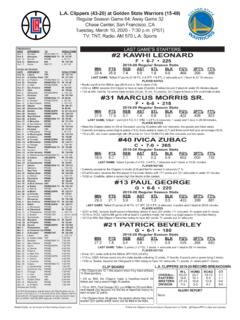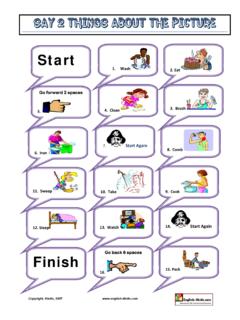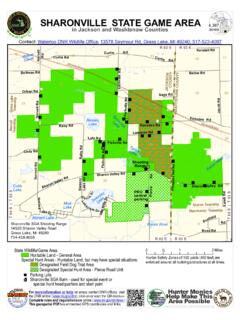Transcription of Work for play - Bureau of Labor Statistics
1 Work for play:Careers in video game developmentFall 2011 Occupational Outlook Quarterly 3 Drew Liming and Dennis VilorioDrew Liming is an economist in the Office of Occupational Statistics and Employment Projections, BLS. He is available at (202) 691-5262 or Vilorio is an economist in the Office of Occupational Statistics and Employment Projections, BLS. He is available at (202) 691-5711 or games aren t only for play; they also provide work. The workers, known as game developers, make a living creating the games you enjoy video games is a serious and big business.
2 According to the Entertain-ment Software Association, in 2009, the video game industry had sales in excess of $10 bil-lion and employed more than 32,000 people in 34 states. Creating these games is complex and requires the collaboration of many developers, who perform a variety of tasks, from produc-tion to programming. They work for both small and large game studios to create games that can be played on many different devices, including console systems, computers, and cell article covers career options in video game development. The first section provides an overview of the development process.
3 The second section describes four groups of video game occupations: designers, programmers, artists, and others. The third section covers the skills and training workers need for these jobs. The fourth section discusses the benefits and challenges of working in the video game industry. And the fifth section provides job-seeking tips for a career in video game devel-opment. Suggested resources for additional information are at the end of the of a video gameThe concept for a video game can come from a variety of sources. Many games start as a new idea for a story or technology the devel-opment team would like to explore.
4 Others come from an established property, such as a novel or film. Still others attempt to perfect a style or formula found in another genre or whatever the impetus for its creation, almost every game follows a similar develop-ment process: preproduction, production, and postproduction. The length of this process is often determined at the beginning of the preproduction phase and depends on a game s size and programming games , such as those made for consoles, have more complex program-ming and, therefore, take longer to develop usually between 18 and 30 months.
5 By com-parison, most games that are played on social media and mobile devices require simpler technology, which results in a quicker devel-opment process of a few completed during preproduction lays the foundation upon which a game is built. In this phase, the lead designers outline a game concept with the help of lead artists and pro-grammers. Lead designers also might select a feature, such as an innovative gameplay element or powerful graphics, that makes the game different design teams flesh out a specific part of the game, such as its mechan-ics and storyline.
6 The designers then compile their ideas in a game design document, which describes the game and its features in this document, programmers create a prototype game. Designers use feedback on the prototype to revise game features. Many game studios also use the prototype to secure financing from publishers, allowing the designers to continue developing the the game receives funding, pro-grammers begin building its technological framework. Meanwhile, artists create concept art, such as character illustrations, that helps designers visualize the game. Completion of the prototype signals the start of the produc-tion phase of the production phase, teams of designers, artists, and programmers use the design docu-ment as a guide to create the game.
7 The teams collaborate to make the most of each other s expertise. Art isn t displayed correctly until an engineer makes it work, and it doesn t work until a designer defines how it should work, says Louis Catanzaro, creative director for BeachCooler games in Waltham, Occupational Outlook Quarterly Fall 2011 Artists use concept art to create textures, models, and animations for the characters, levels, objects, and environments that will populate the game world. Programmers final-ize the game engine a video game s physics and graphics systems and tools.
8 They also write the code that dictates everything from the game s rules to how its visual elements are displayed on the meet with workers from the other departments to ensure that the game s design document is being followed. Feedback during production helps the designers revise the document as needed for example, to improve a game s mechanics or remove an unfeasible production, developers con-tinually build improved versions of the game. The goal is to add more dimensions to the game, says David Sirlin, lead designer for Sirlin games in Emeryville, California.
9 That is, to create more content that is better looking within a design that is more refined. At the conclusion of the production phase, the fully playable game includes art, music, and sound effects. This milestone is referred to as content complete. Postproduction and beyondPostproduction focuses on playing the game to test it for errors, called bugs, and on tweaking it to eliminate unwanted quality assurance staff tests the game by playing it and attempting to do things the development staff never considered. As the game testers find bugs, they document the errors and assign them to a programmer, designer, or artist to might also find that parts of the game are inconsistent or imbalanced.
10 Fixing these issues might require tweaks to existing features and with bugs and tweaks can make postproduction time-consuming. The process may take as long as production, especially for more complex games that have bigger a game is released, it is distributed for sale to players. However, the work does not end there. games often need patches, which are frequent updates that might include bug fixes, tweaks to the game s balance, and new content. And a game s success might persuade the studio to develop an expansion a large content and feature update that usually is sold separately as an addition to the original in video game developmentMaking a video game requires many different workers.


















